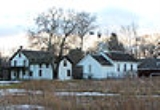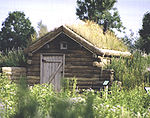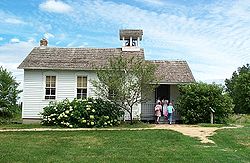
Gibbs Museum of Pioneer and Dakotah Life
Encyclopedia
The Gibbs Museum of Pioneer and Dakotah Life is a farm located at 2097 West Larpenteur Avenue, Falcon Heights
, Minnesota
. The site was the home of Heman Gibbs and Jane DeBow, first built in 1854; the existing farmhouse includes the small, original cabin.
 The museum seeks to educate visitors on the lives of 19th century Minnesota pioneers and the Dakotah people (also called Dakota
The museum seeks to educate visitors on the lives of 19th century Minnesota pioneers and the Dakotah people (also called Dakota
) who lived in southern Minnesota before the arrival of Europeans.
, and school house
, as well as a replica sod house
, bark lodge, and tipi
with replica Dakotah furniture, clothing and tools.
The objects in the farm house date from the mid-19th century on and are part of the Ramsey County Historical Society collection; those belonging to the Gibbs family are featured in the house tour. Objects of particular interest include a family hair wreath, original wallpaper, a concealed murphy bed
and various other original artifacts.
The museum grounds offer visitors a natural Minnesota prairie
as it would have looked like in the 19th Century as well as a Dakotah medicine teaching garden (the turtle garden), Dakotah vegetable garden, pioneer vegetable garden, a heritage apple orchard and farm animals.
In 1974, the farm was listed on the National Register of Historic Places
.
It is open May 1 through October 31, from noon to 4pm Tuesday–Sunday. Admission is $8.00 for adults, $7.00 for seniors and $5.00 for children age 2–16.
 The museum focuses on the story of Jane Gibbs (born Jane DeBow), who was abducted at age five from her home near Batavia, NY in 1835 by the Stevensons, a missionary
The museum focuses on the story of Jane Gibbs (born Jane DeBow), who was abducted at age five from her home near Batavia, NY in 1835 by the Stevensons, a missionary
family. They brought her West to live among the Dakotah people near Fort Snelling, Lake Calhoun
and Lake Harriet where Jane attended the missionary school with the Dakotah children and learned to speak their language. She developed a close relationship with the Dakotah and was given the name "Zitkadan Usawin" (Little Bird that was Caught).
She moved with the Stevensons to Illinois
where Jane met and married Heman Gibbs in Galena in 1848. They returned to Minnesota in 1849 and bought the land that would eventually become the Gibbs Museum of Pioneer and Dakotah Life in 1849.
Shortly after buying the land, Jane and Heman discovered an Indian trail running through it. Soon they found some of the same Dakotah who Jane had grown up with used the trail on their annual migration
North to their wild ricing, hunting and fishing grounds in present day Forest Lake, Minnesota
.
Each year the Dakotah band would stop at the Gibbs farm for up to three weeks to visit with Jane and her family before continuing their journey.
 After buying the land in 1849, Jane and Heman Gibbs built a small, one-room, dug-out sod house where they lived for 5 years while farming the land. The house was 10'x12' and built with logs and featured a sod roof. This design kept the house well insulated in the winter and cool in the summer.
After buying the land in 1849, Jane and Heman Gibbs built a small, one-room, dug-out sod house where they lived for 5 years while farming the land. The house was 10'x12' and built with logs and featured a sod roof. This design kept the house well insulated in the winter and cool in the summer.
The original location was next to the farm house and was excavated in 1995. Now a replica built from the architectural investigation stands in the prairie.
 In 1854 Jane and Heman built a one-room farm house just a few yards away from their sod house. It stayed a one-room house for 13 years, providing shelter for the 5 Gibbs children: Ida (adopted), Abbie, William, Frank and Lillie.
In 1854 Jane and Heman built a one-room farm house just a few yards away from their sod house. It stayed a one-room house for 13 years, providing shelter for the 5 Gibbs children: Ida (adopted), Abbie, William, Frank and Lillie.
In 1867 the house was enlarged to meet the space needs of the family. The one-room house became an eight-room farm house as big and modern as any in the area. The enlarged house featured a parlor, six bedrooms, the hired men's room (called the "Pen"), and a summer kitchen.
 Heman Gibbs was an educated man and believed in education for his own children and those in the area. In 1871 he sold the land across the street for a schoolhouse and while it was being built he allowed class to be held in the farm house. The Gibbs family also boarded the teacher in their house.
Heman Gibbs was an educated man and believed in education for his own children and those in the area. In 1871 he sold the land across the street for a schoolhouse and while it was being built he allowed class to be held in the farm house. The Gibbs family also boarded the teacher in their house.
The schoolhouse on the museum grounds today is not the original Heman was instrumental in getting built. This one was built around the same time near Milan, Minnesota
and represents the typical pioneer one-room schoolhouse.
The school house was bought in 1966 for $100 by the Ramsey County Historical Society and had to make the 140 mile journey to the Gibbs Museum of Pioneer and Dakotah life between the hours of 9am–3pm while avoiding all major highways or roads.
Falcon Heights, Minnesota
As of the census of 2000, there were 5,572 people, 2,103 households, and 1,434 families residing in the city. The population density was 2,487.9 people per square mile . There were 2,136 housing units at an average density of 953.7 per square mile...
, Minnesota
Minnesota
Minnesota is a U.S. state located in the Midwestern United States. The twelfth largest state of the U.S., it is the twenty-first most populous, with 5.3 million residents. Minnesota was carved out of the eastern half of the Minnesota Territory and admitted to the Union as the thirty-second state...
. The site was the home of Heman Gibbs and Jane DeBow, first built in 1854; the existing farmhouse includes the small, original cabin.

Sioux
The Sioux are Native American and First Nations people in North America. The term can refer to any ethnic group within the Great Sioux Nation or any of the nation's many language dialects...
) who lived in southern Minnesota before the arrival of Europeans.
Description
An open-air museum, the Gibbs Museum features an original farm house, barnBarn
A barn is an agricultural building used for storage and as a covered workplace. It may sometimes be used to house livestock or to store farming vehicles and equipment...
, and school house
School
A school is an institution designed for the teaching of students under the direction of teachers. Most countries have systems of formal education, which is commonly compulsory. In these systems, students progress through a series of schools...
, as well as a replica sod house
Sod house
The sod house or "soddy" was a corollary to the log cabin during frontier settlement of Canada and the United States. The prairie lacked standard building materials such as wood or stone; however, sod from thickly-rooted prairie grass was abundant...
, bark lodge, and tipi
Tipi
A tipi is a Lakota name for a conical tent traditionally made of animal skins and wooden poles used by the nomadic tribes and sedentary tribal dwellers of the Great Plains...
with replica Dakotah furniture, clothing and tools.
The objects in the farm house date from the mid-19th century on and are part of the Ramsey County Historical Society collection; those belonging to the Gibbs family are featured in the house tour. Objects of particular interest include a family hair wreath, original wallpaper, a concealed murphy bed
Murphy bed
A Murphy Bed , also called a wall bed, pull down bed or fold-down bed is a bed that is hinged at one end to store vertically against the wall, or inside a closet or cabinet. To achieve this, the mattress is attached to the bed frame, often with elastic straps. Mulrphy beds are used for space-saving...
and various other original artifacts.
The museum grounds offer visitors a natural Minnesota prairie
Prairie
Prairies are considered part of the temperate grasslands, savannas, and shrublands biome by ecologists, based on similar temperate climates, moderate rainfall, and grasses, herbs, and shrubs, rather than trees, as the dominant vegetation type...
as it would have looked like in the 19th Century as well as a Dakotah medicine teaching garden (the turtle garden), Dakotah vegetable garden, pioneer vegetable garden, a heritage apple orchard and farm animals.
In 1974, the farm was listed on the National Register of Historic Places
National Register of Historic Places
The National Register of Historic Places is the United States government's official list of districts, sites, buildings, structures, and objects deemed worthy of preservation...
.
It is open May 1 through October 31, from noon to 4pm Tuesday–Sunday. Admission is $8.00 for adults, $7.00 for seniors and $5.00 for children age 2–16.
History

Missionary
A missionary is a member of a religious group sent into an area to do evangelism or ministries of service, such as education, literacy, social justice, health care and economic development. The word "mission" originates from 1598 when the Jesuits sent members abroad, derived from the Latin...
family. They brought her West to live among the Dakotah people near Fort Snelling, Lake Calhoun
Lake Calhoun
Lake Calhoun is the biggest lake in Minneapolis, Minnesota, and part of the city's Chain of Lakes. Surrounded by city park land and circled by bike and walking trails, it is popular for many outdoor activities...
and Lake Harriet where Jane attended the missionary school with the Dakotah children and learned to speak their language. She developed a close relationship with the Dakotah and was given the name "Zitkadan Usawin" (Little Bird that was Caught).
She moved with the Stevensons to Illinois
Illinois
Illinois is the fifth-most populous state of the United States of America, and is often noted for being a microcosm of the entire country. With Chicago in the northeast, small industrial cities and great agricultural productivity in central and northern Illinois, and natural resources like coal,...
where Jane met and married Heman Gibbs in Galena in 1848. They returned to Minnesota in 1849 and bought the land that would eventually become the Gibbs Museum of Pioneer and Dakotah Life in 1849.
Shortly after buying the land, Jane and Heman discovered an Indian trail running through it. Soon they found some of the same Dakotah who Jane had grown up with used the trail on their annual migration
Human migration
Human migration is physical movement by humans from one area to another, sometimes over long distances or in large groups. Historically this movement was nomadic, often causing significant conflict with the indigenous population and their displacement or cultural assimilation. Only a few nomadic...
North to their wild ricing, hunting and fishing grounds in present day Forest Lake, Minnesota
Forest Lake, Minnesota
Forest Lake is a city in Washington County, Minnesota, United States. The population was 18,375 at the 2010 census. It is located on Minnesota's 94th largest lake .Interstate 35 and U.S...
.
Each year the Dakotah band would stop at the Gibbs farm for up to three weeks to visit with Jane and her family before continuing their journey.
Sod house

The original location was next to the farm house and was excavated in 1995. Now a replica built from the architectural investigation stands in the prairie.
Farm house

In 1867 the house was enlarged to meet the space needs of the family. The one-room house became an eight-room farm house as big and modern as any in the area. The enlarged house featured a parlor, six bedrooms, the hired men's room (called the "Pen"), and a summer kitchen.
School house

The schoolhouse on the museum grounds today is not the original Heman was instrumental in getting built. This one was built around the same time near Milan, Minnesota
Milan, Minnesota
Milan is a city in Chippewa County, Minnesota, United States. The population was 369 at the 2010 census.-Geography:According to the United States Census Bureau, the city has a total area of , all of it land.U.S...
and represents the typical pioneer one-room schoolhouse.
The school house was bought in 1966 for $100 by the Ramsey County Historical Society and had to make the 140 mile journey to the Gibbs Museum of Pioneer and Dakotah life between the hours of 9am–3pm while avoiding all major highways or roads.

